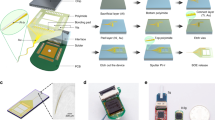Abstract
There have been various types of interconnection methods for neural interfacing electrodes, such as silicon ribbon cables, wire bonding and polymer-based cables. In this study, interconnection cables were developed for integration with a Flexible Penetrating Microelectrode Array (FPMA) that was previously developed for neural signal recording or stimulation. Polyimide and parylene C were selected as base materials for the interconnection cables as both materials can preserve the flexibility of the FPMA better than other interconnection methods such as silicon ribbon cable or wire bonding. We conducted durability tests to determine if the interconnection cables were suitable for in-vivo implantation, by long-term soaking of the cables in phosphate buffered saline solution. We measured the changes in impedance over time, and equivalent circuit models were used to analyze the electrochemical phenomena on the surface of the cables. Lastly, we implanted the cable-integrated electrodes device onto rabbit’s sciatic nerve and recorded neural signals to prove the feasibility of the developed FPMA integration system.













Similar content being viewed by others
Change history
02 November 2017
The original version of this article unfortunately contained a mistake. In Eqs. (1) to (3), the gas constant ‘R’ should be replaced with Boltzmann constant ‘k B.’ This change accompanies the change in the paragraph following Eq. (3) as below:
References
M.R. Abidian, D.C. Martin, Experimental and theoretical characterization of implantable neural microelectrodes modified with conducting polymer nanotubes. Biomaterials 29, 1273–1283 (2008)
R. Bhandari, S. Negi, R. Van Wagenen, F. Solzbacher, Parylene C-based flexible interface for neuroprosthetic applications. Proc. Electron Compon Technol Conf, 1010–1014 (2010)
D. Byun, S.J. Cho, S. Kim, Fabrication of a flexible penetrating microelectrode array for use on curved. J. Micromech. Microeng. 23, 125010 (2013)
J.H. Chang, J. Park, Y.K. Pak, J.J. Pak, Fitting improvement using a new electrical circuit model for the electrode-electrolyte interface. Proc. 3rd Int. IEEE EMBS Conf. Neural Eng, 572–574 (2007)
M.-Y. Cheng, W.-T. Park, A. Yu, R.-F. Xue, K.L. Tan, D. Yu, S.-H. Lee, C.L. Gan, M. Je, A flexible polyimide cable for implantable neural probe arrays. Microsyst. Technol. 19, 1111–1118 (2013)
I.H. Cho, H. Shin, H.J. Lee, I.J. Cho, Effects of fabrication process variation on impedance of neural probe microelectrodes. J. Electr. Eng. Technol. 10, 30–40 (2015)
W. Chun, N. Chou, S. Cho, S. Yang, S. Kim, Evaluation of sub-micrometer parylene C films as an insulation layer using electrochemical impedance spectroscopy. Prog. Org. Coatings 77, 537–547 (2014)
S.F. Cogan, Neural stimulation and recording electrodes. Annu. Rev. Biomed. Eng. 10, 275–309 (2008)
P. Flowers et al., Chemistry, OpenStax, Houston, TX (2015)
W. Franks, I. Schenker, P. Schmutz, A. Hierlemann, Impedance characterization and modeling of electrodes for biomedical applications. IEEE Trans. Biomed. Eng. 52, 1295–1302 (2005)
M. Ghosh, Polyimides: Fundamentals and Applications, CRC Press, Boca Raton, FL (1996)
D.W.L. Hukins, A. Mahomed, S.N. Kukureka, Accelerated aging for testing polymeric biomaterials and medical devices. Med. Eng. Phys. 30, 1270–1274 (2008)
K.E. Jones, P.K. Campbell, R.A. Normann, A glass/silicon composite intracortical electrode array. Ann. Biomed. Eng. 20, 423–437 (1992)
S. Kisban, S. Herwik, K. Seidl, B. Rubehn, A. Jezzini, M.A. Umiltà, L. Fogassi, T. Stieglitz, O. Paul, P. Ruther, Microprobe array with low impedance electrodes and highly flexible polyimide cables for acute neural recording. Proc. Annu. Int. Conf. IEEE Eng. Med. Biol, 175–178 (2007)
C.D. Lee, E. Meng, Mechanical properties of thin-film Parylene–metal–Parylene devices. Frontiers in Mechanical Engineering 1, 10 (2015)
W. Li, D.C. Rodger, E. Meng, J.D. Weiland, M.S. Humayun, Y.C. Tai, Wafer-level parylene packaging with integrated rf electronics for wireless retinal prostheses. J. Microelectromech. Syst. 19, 735–742 (2010)
P.R. Menon, W. Li, A. Tooker, Y.C. Tai, Characterization of water vapor permeation through thin film parylene C. Proc. 15th Int. Conf. Solid-State Sensors, Actuators Microsystems, 1892–1895 (2009)
R.P. Metzen, T. Stieglitz, The effects of annealing on mechanical, chemical, and physical properties and structural stability of Parylene C. Biomed Microdevices 15, 727-735 (2013)
J.U. Meyer, T. Stieglitz, O. Scholz, W. Haberer, H. Beutel, High density interconnects and flexible hybrid assemblies for active biomedical implants. IEEE Trans. Adv. Packag. 24, 366–374 (2001)
S. Musallam, M.J. Bak, P.R. Troyk, R.A. Andersen, A floating metal microelectrode array for chronic implantation. J. Neurosci. Methods 160, 122–127 (2007)
C.T. Nordhausen, E.M. Maynard, R.A. Normann, Single unit recording capabilities of a 100 microelectrode array. Brain Res. 726, 129–140 (1996)
S.J. Park, Y.J. Lee, D.N. Heo, I.K. Kwon, K.-S. Yun, J.Y. Kang, S.H. Lee, Functional nerve cuff electrode with controllable anti-inflammatory drug loading and release by biodegradable nanofibers and hydrogel deposition. Sensors Actuators B Chem. 215, 133–141 (2015)
P.J. Rousche, D.S. Pellinen, D.P. Pivin, J.C. Williams, R.J. Vetter, D.R. Kipke, Flexible polyimide-based intracortical electrode arrays with bioactive capability. IEEE Trans. Biomed. Eng. 48, 361–371 (2001)
B. Rubehn, T. Stieglitz, In vitro evaluation of the long-term stability of polyimide as a material for neural implants. Biomater. 31, 3449-3458 (2010)
K.L. Tan, M.-Y. Cheng, P.G. Teh, W.T. Park, M. Je, Integration of low profile neural probe array with flexible polyimide cable. Proc. 13th Electron. Packag. Technol. Conf, 785–788 (2011)
D. Yu, M.-Y. Cheng, L.S. Lim, P. Myo, A. Yu, Newly developed integration method for biomedical implants using flexible polymer cable. Proc. 12th Electron. Packag. Technol. Conf, 388–392 (2010)
Acknowledgements
This research was supported by grants from the Basic Science Research Program through the National Research Foundation (NRF-2017R1A2B2004598) and DGIST R&D Program (16-BD-0404) funded by the Ministry of Science, ICT & Future Planning, and the Robot Industry Fusion Core Technology Development Project (10052980) through the Korea Evaluation Institute of Industrial Technology funded by the Ministry of Trade, Industry and Energy of Korea.
Author information
Authors and Affiliations
Corresponding author
Additional information
A correction to this article is available online at https://doi.org/10.1007/s10544-017-0232-x.
Rights and permissions
About this article
Cite this article
Oh, K., Byun, D. & Kim, S. Polymer-based interconnection cables to integrate with flexible penetrating microelectrode arrays. Biomed Microdevices 19, 76 (2017). https://doi.org/10.1007/s10544-017-0217-9
Published:
DOI: https://doi.org/10.1007/s10544-017-0217-9




